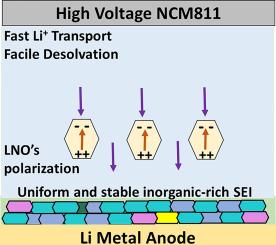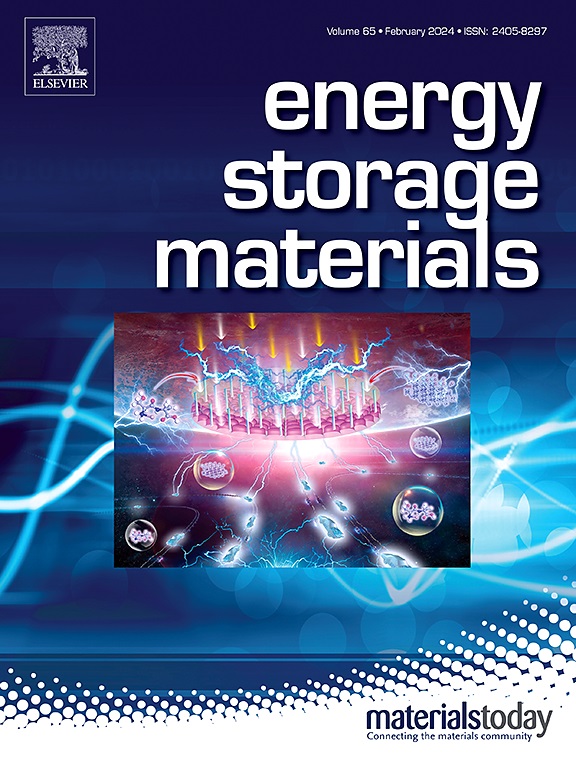Dielectric additive induced weak Li solvation towards stabilized solid electrolyte interface for 4.6V lithium metal batteries
IF 18.9
1区 材料科学
Q1 CHEMISTRY, PHYSICAL
引用次数: 0
Abstract
Developing stable electrode-electrolyte interphases on Li metal anode (LMA) and high voltage cathode is crucial for producing durable Li metal batteries. Electrolyte engineering has been regarded as an efficient way to in-situ construct stable and robust interphase. Herein, a dielectric electrolyte system is proposed by introducing LiNbO3 nanoparticles to liquid carbonate-based electrolyte for regulating Li+ solvation structure, and thus inducing stable inorganic-rich solid electrolyte interphase. Moreover, these dielectric nano LiNbO3 additives can regulate the Li+ flux through their build-in electric field to guide dendrite free Li deposition. These multi-functional features of LiNbO3 allow for exceptional cyclic performance in both symmetric cell configuration (3300 h at 0.5 mA cm−2 and 1 mA h cm−2) and Li||LiNi0.8Co0.1Mn0.1O2 half-cell charged at 4.6 V with capacity retention of 80% over 200 cycles. These results demonstrate great potential of dielectric electrolyte on improving the performance of lithium metal batteries.


电介质添加剂诱导弱锂离子溶入稳定的固体电解质界面,用于 4.6 V 锂金属电池
在锂金属阳极(LMA)和高压阴极上开发稳定的电解质间相对于生产耐用的锂金属电池至关重要。电解质工程被认为是在原位构建稳定而坚固的电解质相的有效方法。本文提出了一种介电电解质系统,通过在液态碳酸盐电解质中引入 LiNbO3 纳米粒子来调节 Li+ 溶解结构,从而诱导稳定的富无机 SEI。此外,这些介电纳米 LiNbO3 添加剂还能通过其内置电场调节 Li+ 通量,从而引导无枝晶锂沉积。铌酸锂(LNO)的这些多功能特性使其在对称电池配置(在 0.5 mA cm-2 和 1 mA h cm-2 条件下分别充电 3300 小时)和在 4.6 V 电压下充电的 Li||LiNi0.8Co0.1Mn0.1O2 半电池中都具有优异的循环性能,在 200 次循环中容量保持率达到 80%。这些结果表明电介质电解液在提高锂金属电池性能方面具有巨大潜力。
本文章由计算机程序翻译,如有差异,请以英文原文为准。
求助全文
约1分钟内获得全文
求助全文
来源期刊

Energy Storage Materials
Materials Science-General Materials Science
CiteScore
33.00
自引率
5.90%
发文量
652
审稿时长
27 days
期刊介绍:
Energy Storage Materials is a global interdisciplinary journal dedicated to sharing scientific and technological advancements in materials and devices for advanced energy storage and related energy conversion, such as in metal-O2 batteries. The journal features comprehensive research articles, including full papers and short communications, as well as authoritative feature articles and reviews by leading experts in the field.
Energy Storage Materials covers a wide range of topics, including the synthesis, fabrication, structure, properties, performance, and technological applications of energy storage materials. Additionally, the journal explores strategies, policies, and developments in the field of energy storage materials and devices for sustainable energy.
Published papers are selected based on their scientific and technological significance, their ability to provide valuable new knowledge, and their relevance to the international research community.
 求助内容:
求助内容: 应助结果提醒方式:
应助结果提醒方式:


